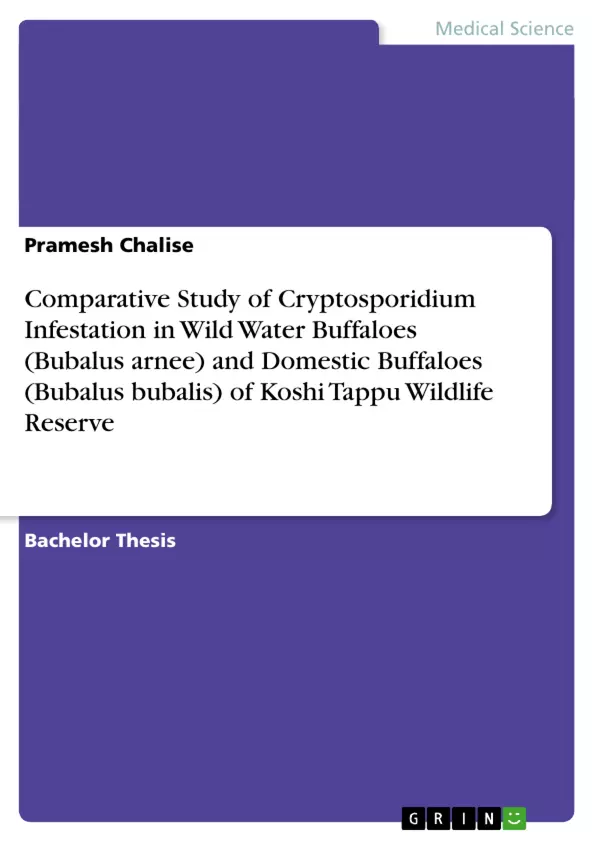Cryptosporidium is an important zoonotic pathogen transmitted primarily through water. This study was conducted to determine the occurrence of Cryptosporidium in wild water buffalo and domestic buffalo in relation to the river water in the river basins of SaptaKoshi. This cross sectional study was conducted from June 2013 to October 2013. A total of 200 dung samples (100 wild water buffalo and 100 domestic buffalo living near the river basins of Sapta Koshi) were examined for the presence of Cryptosporidium by Ziehl-Neelsen Staining technique after Modified Sheather concentration method with centrifugation. A comparative study has been conducted between pre monsoon study and post monsoon study. Overall 6% were positive for Cryptosporidium oocysts, wild water buffalo having higher chances of being infected than domestic buffalo (P < 0.05). The prevalence was higher in post monsoon than pre monsoon (P<0.05). Cryptosporidium has been identified in wild water buffalo and domestic buffalo residing in the periphery of SaptaKoshi river basin establishing river as an epidemiological factor for transmission. Cryptosporidiosis is reported for the first time in wild water buffalo in Nepal. Thus, the study suggests further research for the conservation of endangered wild water buffalo.
Inhaltsverzeichnis (Table of Contents)
- Introduction
- Background
- Classification
- Pathogenesis
- Epidemiology
- Transmission pattern
- Justification of the study
- Background
Zielsetzung und Themenschwerpunkte (Objectives and Key Themes)
This study aims to determine the prevalence of Cryptosporidiosis in wild water buffalo in Nepal. The study addresses a knowledge gap in the field and contributes to conservation efforts by focusing on a vulnerable population. The study highlights the importance of understanding protozoan parasite infestations in both wild and domesticated buffalo populations, which can impact the health and survival of young calves. Key themes include:- Prevalence of Cryptosporidiosis in wild water buffalo in Nepal
- Impact of Cryptosporidiosis on animal health and survival
- Zoonotic transmission and potential public health risks
- Conservation efforts for vulnerable wild water buffalo populations
Zusammenfassung der Kapitel (Chapter Summaries)
Introduction
This section provides a comprehensive overview of Cryptosporidium species, their life cycle, and their impact on both human and animal health. It delves into the classification, pathogenesis, epidemiology, and transmission patterns of Cryptosporidium, highlighting the importance of understanding this zoonotic pathogen.Justification of the Study
This section justifies the need for this study, emphasizing the absence of previous research on Cryptosporidiosis in wild water buffalo in Nepal. The study aims to bridge this knowledge gap and contribute to conservation efforts by focusing on a vulnerable population.Schlüsselwörter (Keywords)
Cryptosporidiosis, Cryptosporidium, wild water buffalo, Nepal, zoonotic, prevalence, animal health, conservation, pathogenesis, epidemiology, transmission, public health.- Arbeit zitieren
- Pramesh Chalise (Autor:in), 2013, Comparative Study of Cryptosporidium Infestation in Wild Water Buffaloes (Bubalus arnee) and Domestic Buffaloes (Bubalus bubalis) of Koshi Tappu Wildlife Reserve, München, GRIN Verlag, https://www.grin.com/document/271150



